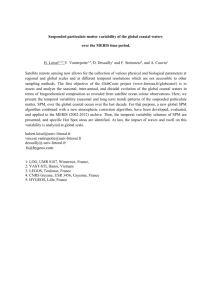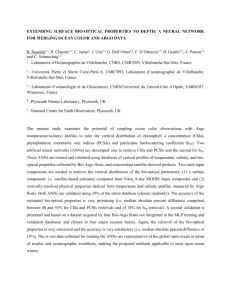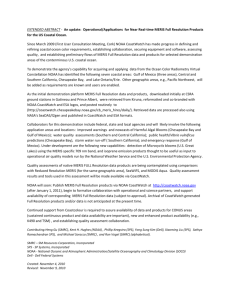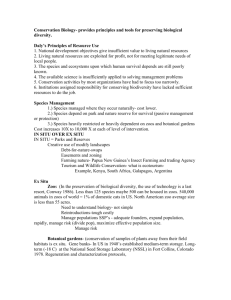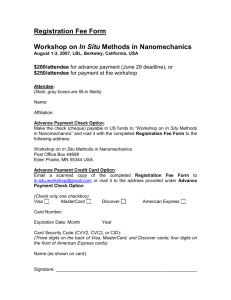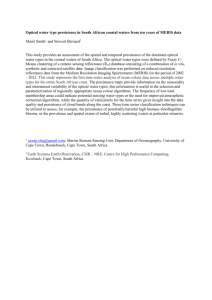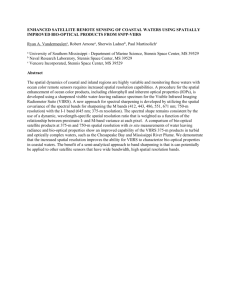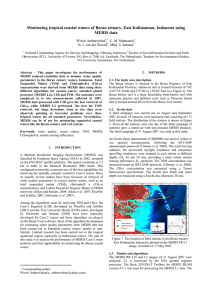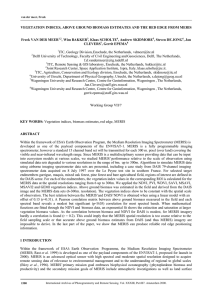Document 11770654
advertisement
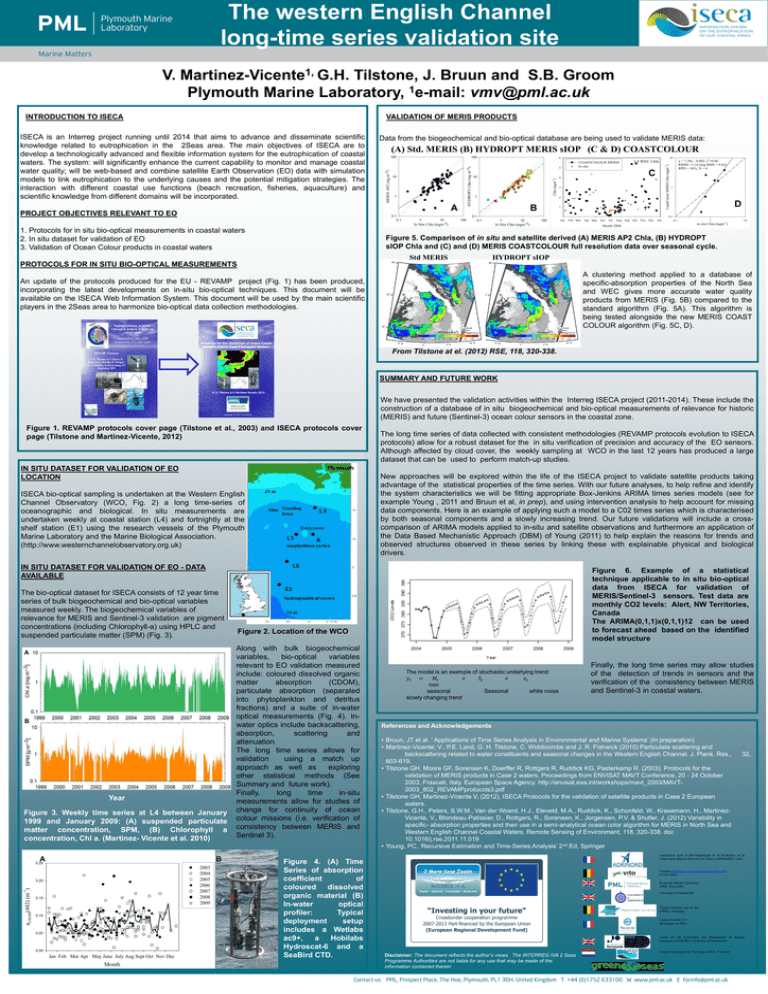
The western English Channel long-time series validation site V. Martinez-Vicente1, G.H. Tilstone, J. Bruun and S.B. Groom 1 Plymouth Marine Laboratory, e-mail: vmv@pml.ac.uk VALIDATION OF MERIS PRODUCTS Data from the biogeochemical and bio-optical database are being used to validate MERIS data: (A) Std. MERIS (B) HYDROPT MERIS sIOP (C & D) COASTCOLOUR 100 1 AA PROJECT OBJECTIVES RELEVANT TO EO 0.1 0.1 1 10 In Situ Chla (mgm-3) 1. Protocols for in situ bio-optical measurements in coastal waters 2. In situ dataset for validation of EO 3. Validation of Ocean Colour products in coastal waters 100 10 10 C 4 -3 1 3 2 BB 0.1 0.1 2 y = 1.38x - 0.002, r =0.60 RMSE =1.16 (log RMS = 0.42) RPD = 36%, N = 6 L4 WEC Chla -3 COASTCOLOUR MERIS In situ 5 Chla (mgm ) 10 6 CoastColour MERIS Chla (mgm ) 100 HYDROPT Chla (mg m-3) ISECA is an Interreg project running until 2014 that aims to advance and disseminate scientific knowledge related to eutrophication in the 2Seas area. The main objectives of ISECA are to develop a technologically advanced and flexible information system for the eutrophication of coastal waters. The system: will significantly enhance the current capability to monitor and manage coastal water quality; will be web-based and combine satellite Earth Observation (EO) data with simulation models to link eutrophication to the underlying causes and the potential mitigation strategies. The interaction with different coastal use functions (beach recreation, fisheries, aquaculture) and scientific knowledge from different domains will be incorporated. MERIS AP2 (mg m-3) INTRODUCTION TO ISECA 1 1 D 0.1 1 10 100 Jan Feb Mar Apr May Jun In Situ Chla (mgm-3) Jul Aug Sep Oct Nov Dec Jan 0.1 1 10 in situ Chla (mgm-3) Month 2006 Figure 5. Comparison of in situ and satellite derived (A) MERIS AP2 Chla, (B) HYDROPT sIOP Chla and (C) and (D) MERIS COASTCOLOUR full resolution data over seasonal cycle. Std MERIS HYDROPT sIOP PROTOCOLS FOR IN SITU BIO-OPTICAL MEASUREMENTS A clustering method applied to a database of specific-absorption properties of the North Sea and WEC gives more accurate water quality products from MERIS (Fig. 5B) compared to the standard algorithm (Fig. 5A). This algorithm is being tested alongside the new MERIS COAST COLOUR algorithm (Fig. 5C, D). An update of the protocols produced for the EU - REVAMP project (Fig. 1) has been produced, incorporating the latest developments on in-situ bio-optical techniques. This document will be available on the ISECA Web Information System. This document will be used by the main scientific players in the 2Seas area to harmonize bio-optical data collection methodologies. From Tilstone at el. (2012) RSE, 118, 320-338. SUMMARY AND FUTURE WORK We have presented the validation activities within the Interreg ISECA project (2011-2014). These include the construction of a database of in situ biogeochemical and bio-optical measurements of relevance for historic (MERIS) and future (Sentinel-3) ocean colour sensors in the coastal zone. Figure 1. REVAMP protocols cover page (Tilstone et al., 2003) and ISECA protocols cover page (Tilstone and Martinez-Vicente, 2012) IN SITU DATASET FOR VALIDATION OF EO LOCATION The long time series of data collected with consistent methodologies (REVAMP protocols evolution to ISECA protocols) allow for a robust dataset for the in situ verification of precision and accuracy of the EO sensors. Although affected by cloud cover, the weekly sampling at WCO in the last 12 years has produced a large dataset that can be used to perform match-up studies. New approaches will be explored within the life of the ISECA project to validate satellite products taking advantage of the statistical properties of the time series. With our future analyses, to help refine and identify the system characteristics we will be fitting appropriate Box-Jenkins ARIMA times series models (see for example Young , 2011 and Bruun et al, in prep), and using intervention analysis to help account for missing data components. Here is an example of applying such a model to a C02 times series which is characterised by both seasonal components and a slowly increasing trend. Our future validations will include a crosscomparison of ARIMA models applied to in-situ and satellite observations and furthermore an application of the Data Based Mechanistic Approach (DBM) of Young (2011) to help explain the reasons for trends and observed structures observed in these series by linking these with explainable physical and biological drivers. ISECA bio-optical sampling is undertaken at the Western English Channel Observatory (WCO, Fig. 2) a long time-series of oceanographic and biological. In situ measurements are undertaken weekly at coastal station (L4) and fortnightly at the shelf station (E1) using the research vessels of the Plymouth Marine Laboratory and the Marine Biological Association. (http://www.westernchannelobservatory.org.uk) IN SITU DATASET FOR VALIDATION OF EO - DATA AVAILABLE The bio-optical dataset for ISECA consists of 12 year time series of bulk biogeochemical and bio-optical variables measured weekly. The biogeochemical variables of relevance for MERIS and Sentinel-3 validation are pigment concentrations (including Chlorophyll-a) using HPLC and suspended particulate matter (SPM) (Fig. 3). A B Year Figure 3. Weekly time series at L4 between January 1999 and January 2009: (A) suspended particulate matter concentration, SPM, (B) Chlorophyll a concentration, Chl a. (Martinez- Vicente et al. 2010) A B 0.25 2003 2004 2005 2006 2007 2008 2009 -1 aCDOM(442) (m ) 0.20 0.15 0.10 0.05 0.00 Jan Feb Mar Apr May June July Aug Sept Oct Nov Dec Month Figure 6. Example of a statistical technique applicable to in situ bio-optical data from ISECA for validation of MERIS/Sentinel-3 sensors. Test data are monthly CO2 levels: Alert, NW Territories, Canada The ARIMA(0,1,1)x(0,1,1)12 can be used to forecast ahead based on the identified model structure Figure 2. Location of the WCO Along with bulk biogeochemical variables, bio-optical variables relevant to EO validation measured include: coloured dissolved organic matter absorption (CDOM), particulate absorption (separated into phytoplankton and detritus fractions) and a suite of in-water optical measurements (Fig. 4). Inwater optics include backscattering, absorption, scattering and attenuation. The long time series allows for validation using a match up approach as well as exploring other statistical methods (See Summary and future work). Finally, long time in-situ measurements allow for studies of change for continuity of ocean colour missions (i.e. verification of consistency between MERIS and Sentinel 3). Figure 4. (A) Time Series of absorption coefficient of coloured dissolved organic material (B) In-water optical profiler: Typical deployment setup includes a Wetlabs ac9+, a Hobilabs Hydroscat-6 and a SeaBird CTD. Finally, the long time series may allow studies of the detection of trends in sensors and the verification of the consistency between MERIS and Sentinel-3 in coastal waters. References and Acknowledgements • Bruun, JT et al. ‘ Applications of Time Series Analysis in Environmental and Marine Systems’ (In preparation) • Martinez-Vicente, V., P.E. Land, G. H. Tilstone, C. Widdicombe and J. R. Fishwick (2010) Particulate scattering and backscattering related to water constituents and seasonal changes in the Western English Channel. J. Plank. Res., 603-619. • Tilstone GH, Moore GF, Sorensen K, Doerffer R, Rottgers R, Ruddick KG, Pasterkamp R. (2003). Protocols for the validation of MERIS products in Case 2 waters. Proceedings from ENVISAT MAVT Conference, 20 - 24 October 2003, Frascati, Italy. European Space Agency. http://envisat.esa.int/workshops/mavt_2003/MAVT2003_802_REVAMPprotocols3.pdf • Tilstone GH, Martinez-Vicente V, (2012). ISECA Protocols for the validation of satellite products in Case 2 European waters. • Tilstone, G.H., Peters, S.W.M., Van der Woerd, H.J., Eleveld, M.A., Ruddick, K., Schonfeld, W., Krasemann, H., MartinezVicente, V., Blondeau-Patissier, D., Rottgers, R., Sorensen, K., Jorgensen, P.V. & Shutler, J. (2012) Variability in specific- absorption properties and their use in a semi-analytical ocean color algorithm for MERIS in North Sea and Western English Channel Coastal Waters. Remote Sensing of Environment, 118, 320-338. doi: 10.1016/j.rse.2011.11.019 • Young, PC, ‘Recursive Estimation and Time-Series Analysis’ 2nd Ed, Springer 32, Model : ARIMA(0,1,1)x(0,1,1)12 : residual serial correlation is unstructured Association pour le Développement de la Recherche et de l’Innovation dans le Nord-Pas de Calais (ADRINORD, Lille) Vlaamse instelling voor technologisch onderzoek (VITO, Mol) Plymouth Marine Laboratory (PML, Plymouth) University of Greenwich Vlaams Instituut voor de Zee (VMM, Oostende) Centre NAUSICAA (Boulogne-sur-Mer) Centre for the Economics and Management of Aquatic Resources (CEMARE, University of Portsmouth) Disclaimer: The document reflects the author’s views. The INTERREG IVA 2 Seas Programme Authorities are not liable for any use that may be made of the information contained therein Institut Néerlandais de l’Ecologie (NIOO, Yerseke)

